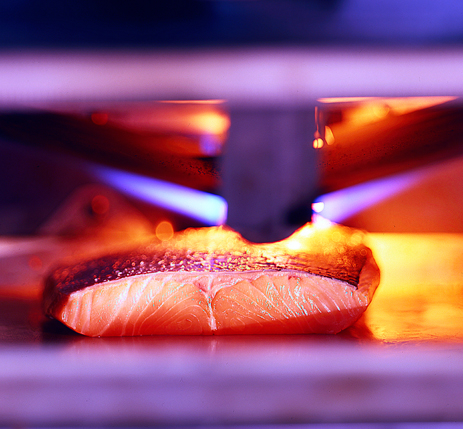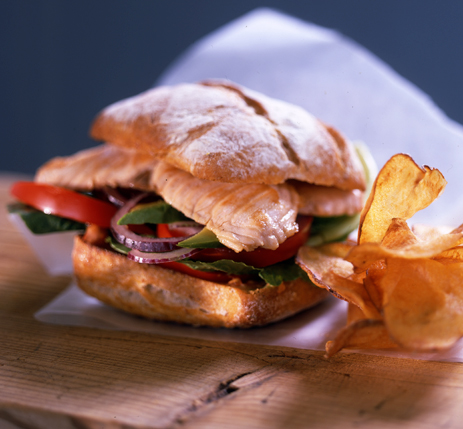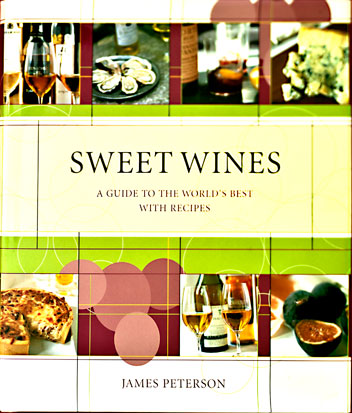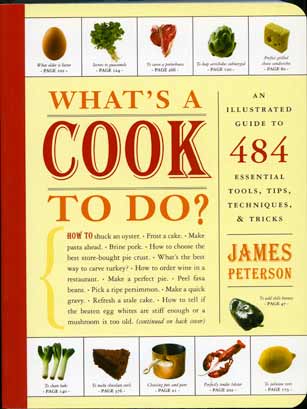by James Peterson
Whether poached or grilled, smoked or sauteed, salmon is as versatile as it is elegant. In Simply Salmon, best-selling cookbook author and acclaimed teacher James Peterson offers 65 irresistible recipes for everyone’s favorite fish.
Using the informative photos and detailed instructions that have become his signature, Peterson gives the home cook a thorough grounding in the basics of salmon: what to look for when buying fresh salmon; the differences between Atlantic and Pacific and wild and farm-raised salmon; how to clean, bone, and skin salmon; and the proper technique for slicing smoked salmon.
The chapters that follow describe all the ways that salmon can be prepared, including sauteing, grilling, poaching, roasting, curing, and smoking. Peterson opens each section with the basic recipe for the method, and then moves on to creative innovations.
Here are updated classics, such as Poached Whole Salmon with Tarragon Butter, Salmon Tartar, and Salmon en Papillote, as well as such original ideas as Sauteed Salmon “Saltimbocca,” Grilled Salmon Salad Nicoise, Salmon Tacos, and Salmon and Basil Ravioli. Where appropriate, recipes for accompanying sauces and condiments are included as well.

Fifty photographs of finished dishes and cooking techniques, taken by Peterson, complement the authoritative text and recipes. This single-subject, comprehensive guide will be a welcome addition to every cook’s bookshelf.
Book Excerpt
Judging Freshness

Because nowadays most salmon available in the market is farmed and the systems for getting it from the farm to the plate are much more efficient than they were in the past, most salmon, at least when it arrives at the fish store, is in excellent condition. Salmon also keeps better than other fish, so a whole salmon that’s several days old and has been properly stored will still be fresh.
Salmon is sold whole (always gutted), cut crosswise into steaks, or in fillets. It is no exception to the rule that it’s easier to judge the freshness of whole fish than filleted fish or fish that’s been cut into steaks. A whole salmon should be so shiny that it sparkles. The skin should be silvery with no dark or gray patches–where scales were rubbed off from mishandling–and the eyes crystal clear and protruding slightly from the head. Lift the cartilaginous flap at the base of the head (called the operculum) or have the fish seller do it so you can look at the gills. The gills should be deep red or pink, and when you stick your nose near them they should have a clean sea-like odor with nothing fishy about them. The end of the tail should be straight and moist and not curling up or drying out at the end.
Judging the freshness of fillets and steaks and making sure you’re getting the freshest pieces may require a little subterfuge. First, buy your salmon in a store that looks and smells clean (again, no fishy smell) with the fish carefully arranged on ice in the display cases and fillets and steaks protected from direct contact with the ice with sheets of shiny paper. Go to a store that’s popular so there’s a lot of turnover. If you’re buying fillets, avoid buying a small tail piece, especially if you see a bunch of tail pieces in the case, left over from the better cuts. If I have any doubts about the freshness of the fish–fillets or steaks with a dull or matte look instead of a sheen–I ask for a whole piece of center-cut fillet or even a whole fillet (much of the time forcing them to fillet a new fish) and cut it up myself when I get it home. If you buy your fish and have any doubts, immediately open the package (I do this while hiding behind a shelf of canned goods) and give it a sniff. If it smells fishy, take it back.


